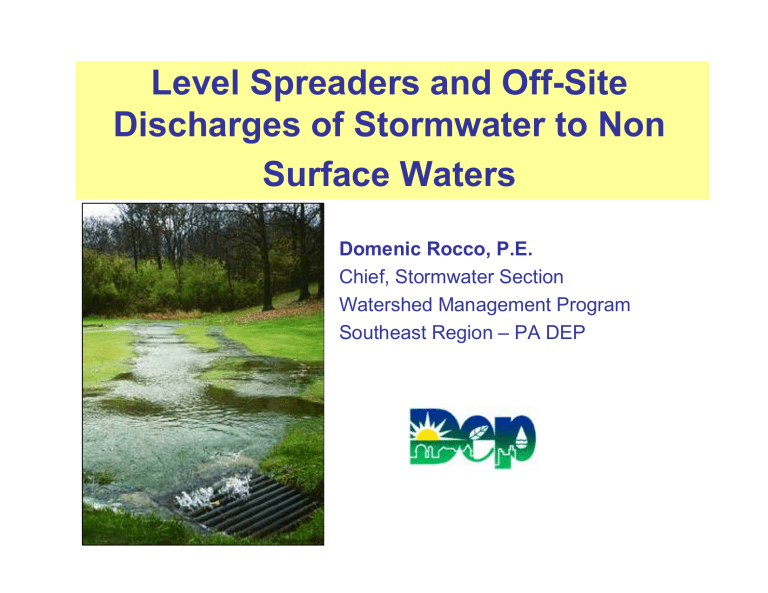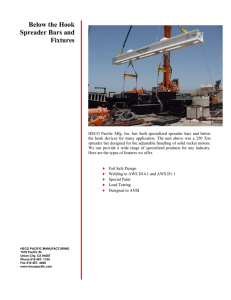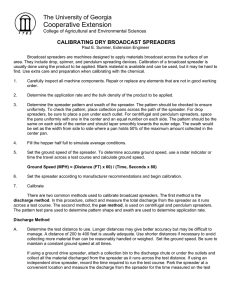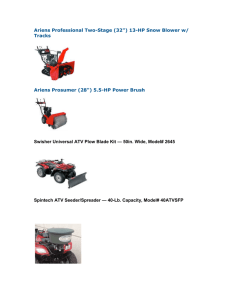
Level Spreaders and Off-Site Discharges of Stormwater to Non Surface Waters Domenic Rocco, P.E. Chief, Stormwater Section Watershed Management Program Southeast Region – PA DEP Disclaimer • Neither a proponent nor an opponent to the use of level spreaders. • Decision to use is typically left with the designer. Purpose • To provide comprehensive guidance on the applicability and proper use of level spreaders. (for both designers and reviewers) • To encourage better design, construction, and monitoring*. • To get beyond the notion that they don’t work. • To establish logical limitations. Collaborative Effort • White Paper • Started in 2004. • Technical Work Group • Inspected ~24 sites and documented their conditions. • Substantial Research • Peer Review Why? • It was needed! • Guidance was lacking or inappropriate. • Observed misuse and poor design. • Several complaints and inquiries. • Observed numerous failures* Failure: Poor siting or geometry X No Plunge Pool Y Undercutting Overtopping Failure: Choice of materials TIMBER Joint? PRE-CAST CONCRETE Fill GABION GABION Failure: Sedimentation TRM Failure: Construction Practices Unlevel Limit Disturbance Short Circuiting Common Level Spreader Failures Unlevel Undercutting Short Circuiting Failed Joint Overtopping What’s Not a Level Spreader? STANDARD CONSTRUCTION DETAIL #33 Riprap Aprons At Pipe Outlets With Flared End Sections • • • • Riprap Aprons Outlet Protection Energy Dissipators Types of Level Spreaders* BMP Manual • Inflow vs. Outflow • Typical vs. Atypical • Surface vs. Subsurface This Paper Other Guidance Inflow vs. Outflow Inflow Outflow BMP flow Source: Cahill Associates Typical vs. Atypical X X Forebay Forebay Influent Stormwater Channel Stable Bypass Buffer Influent Stormwater Channel Buffer Receiving Stream Level Lip Level Lip Diffuse Flow Diffuse Flow Surface vs. Subsurface Discharge Profile View Profile View N.T.S. N.T.S. Suitable rigid measures and protective geofabric (TRM)- min. 3 ft. or as needed. X Turf Reinforcement Mat (3’ Typ.) Outflow Outflow Y Inflow h Plunge Pool Bedding Material No. 3 Stone (clean) Undisturbed Ground Inflow Lip Level Spreader Optional Drain. 2” ductile iron Driven horizontally Geotextile Lining (non-woven) Existing PA DEP Guidance • Paper compliments existing guidance. • E&S Manual requires: Up to 2-year storm – 1 LF per CFS – Temporary use only. – Do not use for permanent/ structural level spreaders. • SWM BMP Manual – BMP 6.8.1- requires: – 13 LF per CFS (grass) – 100 LF per CFS (woods) Up to 100-year storm • Beware of rules of thumb: You need to know where these numbers come from.** Sneak Peek: Technical Paper Paper is organized into several sections: • Practical Considerations: – avoidance and minimization. • Legal Considerations: – analysis of off-site discharge*, easements. • Engineering Considerations: – DA < 5ac, S < 6%, materials, siting, sizing • Outfall Design: – for areas unsuitable for level spreaders • Remedial Actions: – for areas experiencing problems • Length of Level Spreader* Source: NCSU Computing Length of Level Spreader (Surface Discharge) • Based on many factors, but the most critical factor is down slope condition – Allowable velocity • Solve continuity equation and the weir equation simultaneously. Q = VA Q = CwLH3/2 • Solve for V: 1/2 V=1.5 V=1.5 CCww H H1/2 Allowable velocity, where? • • • Not the allowable velocity at the level spreader, but at the effective distance. Flow uses approx. one-third of available land. Therefore, divide erosive velocity of ground cover by 3. – For thick grass: Level Spreader Vallow= 5 fps/3 = 1.33 fps Flow initially fully spread across grade – For woods/no cover: Vallow= 2 fps/3 = 0.67 fps Vallow Here Effective Distance, Ed Flow uses only 1/3 of available land Source: NCSU With Vallow – Find Head (H) Driving Head N.T.S. (Weir Eq. Input) V = 1.5CwH1/2 → solve for Q = CwLH3/2 → solve for L (Continuity Eq. Input) H H Weir Equation: Water Height at Weir H*= 2/3 H Plunge Pool Geofabric Level Spreader Q (cfs) Thick Grass Woods or No Cover L (ft) L (ft) 0.50 6 59 1.00 13 118 1.50 19 177 1.70 21 200 2.00 25 3.00 37 4.00 49 5.00 62 10.00 123 15.00 185 16.00 198 16.20 200 Level Spreader Length • Thick Grass: 13 LF/CFS • Woods / No cover: 100 LF/CFS • Difference: Order of magnitude – Dependent on d/s ground cover condition*. E&S Grass Woods Adequate Ground Cover Filter Strip - Buffer Meadow Forest Inadequate Ground Cover Flow Path • Know your flow path!! – From the point of discharge to the receiving stream. – Design to the worse-case ground cover along the flow path. • Consider alternative discharge points • Site visit is imperative. – Design can’t be done solely from the desktop. Analysis of Off-site Discharge • Analyze downslope conditions: – soils, geology, ground cover, properties, conveyances, receiving stream. • Monitor level spreader and flow path for up to two years • Municipal coordination • Authorization from offsite property owners Stages of Erosion Analysis of Off-site Discharge Forested Ground Cover • Relook at forested ground cover revealed that there were some significant factors that needed to be considered. • Width of Wooden Riparian Buffer – Absorption by mulch cover – Infiltration in underlying (undisturbed) soil HSG A or B Wooded Riparian Buffer Width (ft) HSG C or D Length of Level Spreader per CFS of flow (ft) 50 65 80 100 50 70 150 40 55 Source: NCSU Examples Porter Tract West Vincent Twp., Chester Co. • Concrete sill. • Pulled back at ends to prevent erosion • Area downslope appears stable • Level spreader, in this instance, appears to have E&S function as well. Alice Grim Blvd. Newtown Twp., Del. Co. • DA = 26.27 acres • Installed: 2 years • Some erosion noted but relatively stable. Arbor Lea Concord Twp., Del. Co. • DA = 9.1 ac • Installed: 4.5 years • Detail similar to Alice Grim • D/S Stable • Can hardly notice it. Dickinson Dev. Bethel Twp., Del. Co. • • • • DA = 4.5 ac Installed: 1.5 years D/S looks stable Creek within reasonable distance. Claridan Court Richland Twp., Bucks Co. • Fairly long Level spreader • Built within the berm. • D/S stable (no photos) Hopewell Estates Upper Macungie Twp., Lehigh Co. • Uses ½ sections of 24” HDPEP • Encased in concrete footing. (3 ft deep) • Erosion noted downslope along side at end of riprap apron. FIN • For more information, read the paper. – DEP • ftp://ftp.state.pa.us/pub/dep/SWM/ROCCO-V13.pdf • Questions?




